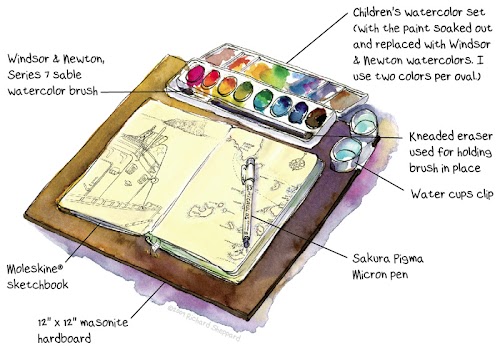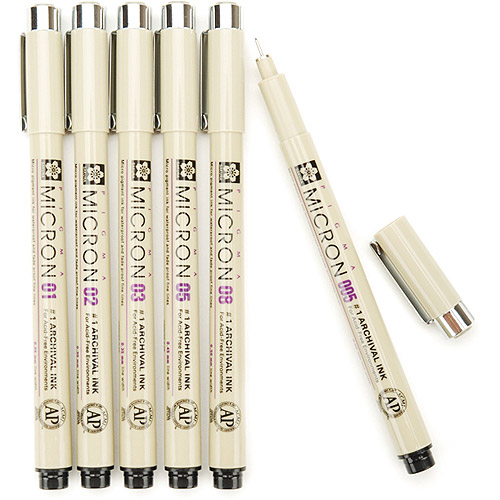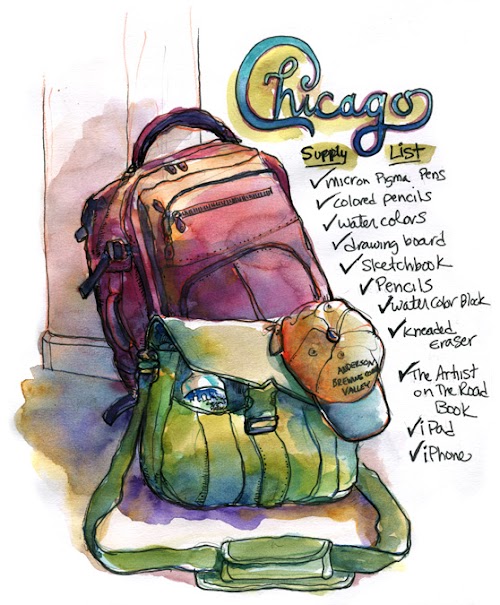
For this interview we have Richard Sheppard. He's a freelance illustrator and fine art artist whose art have appeared in books (e.g. An Illustrated Journey) and galleries. He has also authored a book called The Artist on the Road based on his 2009 trip in Greece.
You can check out his art blog at https://www.theartistontheroad.com or his illustration portfolio at https://www.artstudios.com
Qn: Tell us a bit more about yourself. How long have you been creating art or sketching?
I attended Arizona State University back in the 1980s then transferred to the Academy of Art University in San Francisco where I studied Illustration under Barbara Bradley, Barron Storey, and Howard Brodie. At the Academy, sketchbooks were required and it’s there that I first started sketching out of doors. At the time, it was difficult for me to sketch in public and it wasn’t until I went on an extended sketching trip to Greece that I got beyond my fears.
Since graduating in 1996, I’ve illustrated books, package designs, and publicity materials. I also write and sketch local scenes for our county newspaper. My "Sense of Place" column appears in the Towns section. I’m currently working on my next book "Impressions of Wine Country" to be published in summer 2014.

Qn: What are your tools of trade on the road, and that you use for freelance illustration?
A few years ago, while preparing for my trip to Greece, I designed a sketching kit that I still use today. It combines a masonite backing board, water cups, and a modified children's paint set. I soaked out the cheap original paints, then replaced them with professional grade Winsor & Newton watercolors. I’m really pleased with the paint box because it cost only $4US, and is as sturdy as the expensive ones in the art stores. Plus I prefer having my colours in a row instead of the typical square box. It saves space.
For my illustration work, I use watercolour, pen & ink, and digital media (Adobe Illustrator and Photoshop). Most of my work combines these media to produce theatre posters, graphics for books, and package designs.
Qn: I read from your blog that you use the Sakura Pigma Micron pens from size 01 to 08? Are they good?
I love Pigma Micron pens. They’re permanent, don’t bleed, and provide a range of line widths even within a single pen. They also come in an assortment of colours, several of which I rely upon regularly.

The only downside is that they seem to dry up pretty quickly and are not refillable.
Qn: What watercolours do you use? Have you tried different brands?
I use professional grade Winsor & Newton watercolours. I was required to use these paints while in college and have grown accustomed to the characteristics of each colour. Some paints are opaque, others transparent, and still others are sedimentary. Plus the gum arabic binder has a big influence on how the paint handles on the paper.
I know there are other brands that make quality watercolours, but I’m familiar with Winsor & Newton so I just stick with them.
Qn: In the drawing of your tools above, you said you use two colours per oval pan. I suppose your watercolours are squeezed from tubes. Isn't that going to make your pure colours messy?
While painting, I don’t fill the pans with water so even though there are two colours per oval, it’s still easy enough to brush the colour I’m after without the colour next to it getting in the way. I chose to put similar colours together so if they mix a little, it adds complexity to the colour instead of creating mud.
Qn: What do you think of the Winsor & Newton Series 7 watercolour brush that you're using. Is it too big or small for the size of sketches you're drawing?
The Series 7 brush (size 8) is a great sable brush. It holds paint better than synthetic brushes and makes for a better painting experience.

Note that in my paint kit I use a small piece of kneaded eraser at one end of the tray to hold the brush in place. It keeps the brush from mashing up against the end and ruining the tip.
Qn: That masonite hardboard you use for backing your sketchbooks. Is it necessary?
The masonite hardboard is used as a support for my sketchbook and paint kit while sketching. It’s especially helpful while standing and sketching since my water cups and paints are available for use without setting them down on the ground.
Qn: I see you use the Moleskine sketchbook. Is that the normal sketchbook or the watercolour ones? What do you think about them? Are they worth the money?
Moleskine makes a good quality sketchbook and I especially like that they lie flat during use. But since I learned to make my own sketchbooks, I use my self-mades almost exclusively. At present, I still have a couple of the landscape watercolor Moleskines and will continue to use them until they're filled.


Qn: Wow, you make your own sketchbooks as well. I saw your step-by-step post on your blog (https://www.theartistontheroad.com/?p=2988) on how to make the sketchbook. You said you could not find the perfect sketchbook. What's your ideal perfect sketchbook? Isn't just more convenient to buy a sketchbook?
The biggest problem with commercial sketchbooks is the lack of paper quality. Most don’t handle watercolour very well and since I love to splash copious amounts of water on the page while working, most papers just buckle. I searched everywhere for a sketchbook that worked with my sketching techniques but eventually gave up on commercial brands.
Finally, I discovered a near perfect solution with self-made sketchbooks. Its only deficiency is that the binding requires the purchase of a special tool or the help of a third party supplier. Though I tried for weeks to make a stitched binding that worked, it wasn’t until I had the book spiral bound that I found what I was looking for. The spiral binding allows me to tuck the finished pages underneath to save space and to occasionally tear a page out for a friend, sell to a buyer, or toss an unsightly drawing away. But most important of all, I have my favourite paper to sketch on, which is Arches hot press watercolour paper. Even Arches sketchbooks don’t contain the same quality of paper as the full size sheets so making my own sketchbook solved all my problems.
Qn: You mentioned you bought the binder The Cinch made by We R Memory Keepers. Is it good? What's the paper size that it can bind?
The Cinch works pretty well as a sketchbook binder and I’m glad I bought it. I prefer their metal clamp binders over the plastic spirals because they make a tighter fitting book.
I’ve used commercial binding services such as FedEx Office (in the US) and they do a good job binding sketchbooks too.
But the reason I bought the Cinch is so I didn’t have to drive and wait for FedEx Office to do work I could do myself. The Cinch can bind just about any size sketchbook I want.
Qn: Are there any special precautions to note when binding your own sketchbooks?
I recommend practicing on cheap paper until you get something you’re happy with. The first time I used the Cinch, the holes didn’t align properly, but after practicing a couple of times, I got the hang of it and it worked perfectly.
Qn: What watercolour paper do you use?
My favourite paper is Arches hot press watercolor paper because it’s 100% rag, archival, and won’t yellow over time. Pigments float on the surface of hot press paper better than cold press, giving the colours a more vivid appearance. It also contributes to the water effects that I encourage in my work. And lastly, hot press enables me to remove (or pull out) paint from the page a little more easily than cold press when necessary.
I scan all my sketches into the computer, and Arches hot press paper shows less paper texture than cold press. I often sketch silhouetted drawings so the removal of the paper texture around the image is important to me.

Qn: You mentioned the Timbuk2 and STM messenger bags that you use to bring your art tools around. Are they good? Why two bags?
I purchased the Timbuk2 bag for my trip to Greece. It worked perfectly while traveling abroad and was large enough to not only hold my art supplies, but also many other travel items.
But when I’m out day sketching, my smaller STM bag works great. It’s just large enough to hold a couple of sketchbooks, my sketching kit, water bottles, etc. Each bag has its flaws and subtle annoyances, but these two bags are durable and work well overall for my needs.

Qn: What travel stool do you use, if any? Is it heavy and can you fit that into your bag?
On occasion I carry a generic travel stool that I purchased at a camping store many years ago but it doesn’t fit inside either of my bags. It can be useful to have a stool while out sketching, and occasionally, I’ll tie it to my Timbuk2 bag, but I usually forgo the stool and can usually find a place to sit onsite.
Qn: Which artist do you think we should feature next?
Omar Jaramillo. His watercolours are amazing and I’d love to know more about his techniques and tools.
Comments
You can send your comments to Richard Sheppard at https://www.theartistontheroad.com/?p=4394
Items mentioned may be available at Amazon.com and Amazon.co.uk


